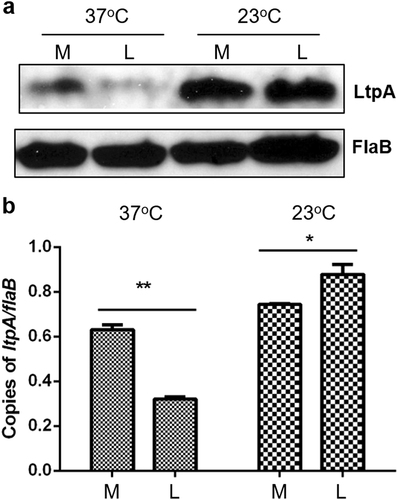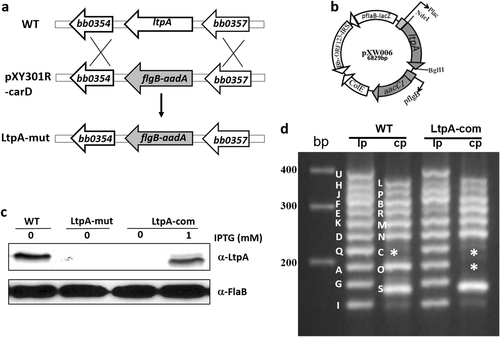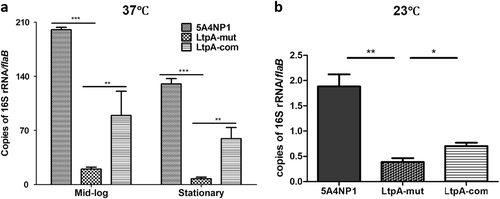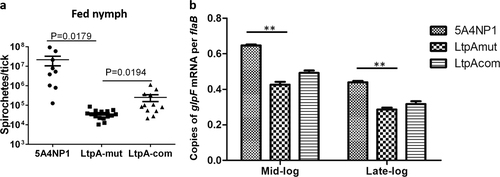Figures & data
B. burgdorferi strain 5A4NP1 was cultured in BSK-II medium at 37 °C or 23 °C. Spirochetes were collected at the mid-log phase (M, 107 spirochetes/ml) or late-log phase (L, 108 spirochetes/ml) then processed for immunoblot (a) and qPCR analyses (b). Levels of FlaB protein and flaB mRNA served as internal controls. *, p < 0.05; **, p < 0.01

a Strategy for constructing the ltpA mutant. WT: genomic structure of ltpA. pXY301R-carD: the suicide vector used for inactivation of ltpA. LtpA-mut: the ltpA mutant. b Diagram of the shuttle vector used for complementation. cB. burgdorferi strains were cultured in BSK-II medium with or without 1 mM IPTG. Spirochetes were collected at the mid-log phase (107 spirochetes/ml) then processed for immunoblotting analysis. WT wild-type B. burgdorferi strain 5A4NP1, Ltp-mut the ltpA mutant, LtpA-com the complementation strain. d Endogenous plasmid profiles of wild-type (WT) and complementation strains (LtpA-com). The ltpA mutant has an identical plasmid profile to that of the WT (not shown). * indicates the band corresponding to plasmid cp32-7 that is missing in LtpA-com

WT, LtpA-mut, and LtpA-com strains were cultured in standard BSK-II medium at 37 °C (a) or 23 °C (b). The initial cell densities for the cultures at 37 °C and 23 °C were 103 spirochetes/ml and 105 spirochetes/ml, respectively. Numbers of spirochetes were enumerated daily using dark-field microscopy. Each data point is derived from the average of the data from three independent cultures. Statistical significance was calculated between LtpA-mut and the WT group. *P < 0.05

WT, LtpA-mut, and LtpA-com strains were cultured in standard BSK-II medium at 37 °C (a) or 23 °C (b). For the culture at 37 °C, spirochetes were collected at the mid-log (107 spirochetes/ml) or stationary phases (5 × 108 spirochetes/ml) and subjected to qRT-PCR analysis. For the culture at 23 °C, spirochetes were collected at a cell density of 107 spirochetes/ml. Each data point was the average of the data from three independent cultures. *, p < 0.05; **, p < 0.01; ***, p < 0.001

Mouse infection of the LtpA-defective mutant
a qPCR analysis of spirochetal burdens in fed nymphs. Flat nymphal ticks were first infected with equal amounts of wild-type, ltpA mutant, and complementation strains of B. burgdorferi by microinjection directly into the midgut of nymphal ticks. Ticks were then allowed to feed on naive mice, and fed nymphal ticks were collected and examined using qPCR analysis. The number of copies of the B. burgdorferi flaB gene was chosen to represent spirochete numbers. Each data point represents flaB copies in one nymph tick. b Transcript levels of glpF in WT, LtpA-mut, and LtpA-com strains as determined using qRT-PCR. RNAs were isolated from mid-logarithmic phase and stationary phase cultures grown at 37 °C in a modified BSK-glycerol medium. The glpF levels were normalized to flaB levels. Values represent the average copy number from three independent cultures. **P < 0.01

Strains, plasmids, and primers used in this study
